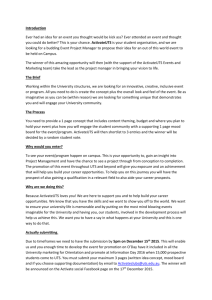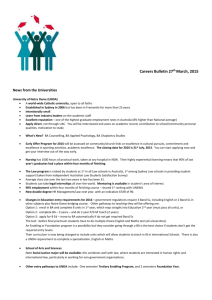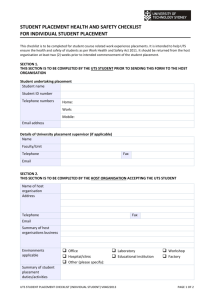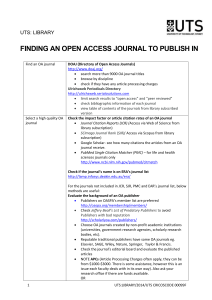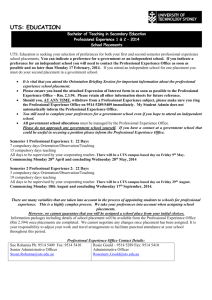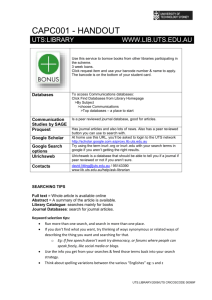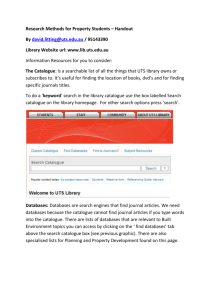Overseas Hazardous Facility
advertisement
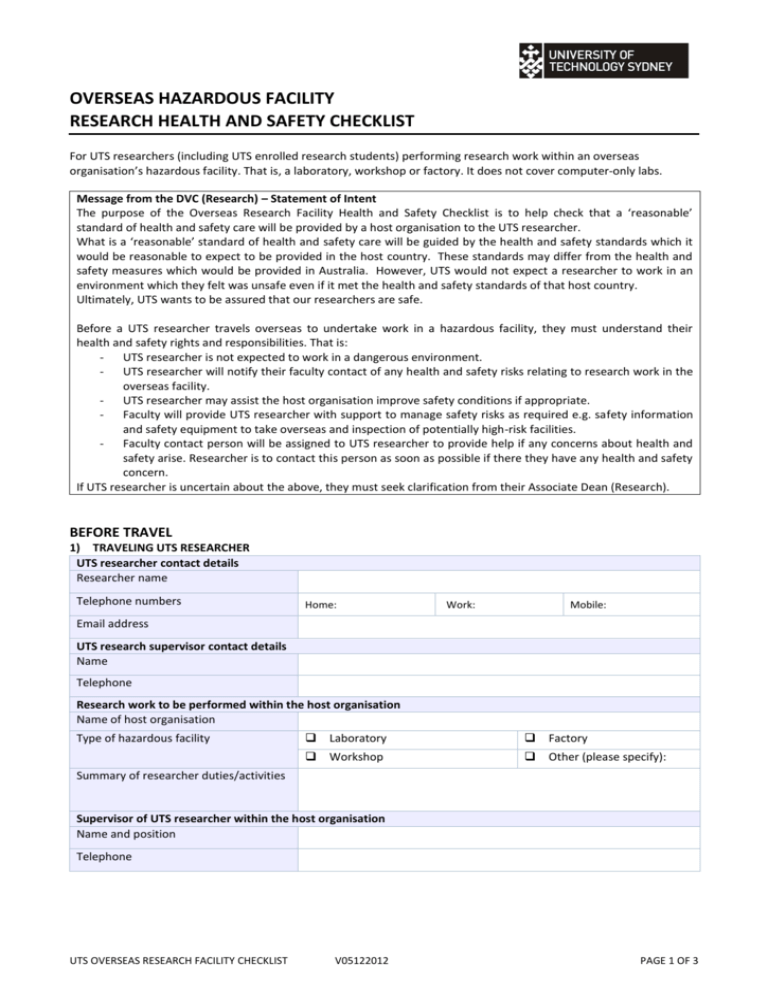
OVERSEAS HAZARDOUS FACILITY RESEARCH HEALTH AND SAFETY CHECKLIST For UTS researchers (including UTS enrolled research students) performing research work within an overseas organisation’s hazardous facility. That is, a laboratory, workshop or factory. It does not cover computer-only labs. Message from the DVC (Research) – Statement of Intent The purpose of the Overseas Research Facility Health and Safety Checklist is to help check that a ‘reasonable’ standard of health and safety care will be provided by a host organisation to the UTS researcher. What is a ‘reasonable’ standard of health and safety care will be guided by the health and safety standards which it would be reasonable to expect to be provided in the host country. These standards may differ from the health and safety measures which would be provided in Australia. However, UTS would not expect a researcher to work in an environment which they felt was unsafe even if it met the health and safety standards of that host country. Ultimately, UTS wants to be assured that our researchers are safe. Before a UTS researcher travels overseas to undertake work in a hazardous facility, they must understand their health and safety rights and responsibilities. That is: UTS researcher is not expected to work in a dangerous environment. UTS researcher will notify their faculty contact of any health and safety risks relating to research work in the overseas facility. UTS researcher may assist the host organisation improve safety conditions if appropriate. Faculty will provide UTS researcher with support to manage safety risks as required e.g. safety information and safety equipment to take overseas and inspection of potentially high-risk facilities. Faculty contact person will be assigned to UTS researcher to provide help if any concerns about health and safety arise. Researcher is to contact this person as soon as possible if there they have any health and safety concern. If UTS researcher is uncertain about the above, they must seek clarification from their Associate Dean (Research). BEFORE TRAVEL 1) TRAVELING UTS RESEARCHER UTS researcher contact details Researcher name Telephone numbers Home: Work: Mobile: Email address UTS research supervisor contact details Name Telephone Research work to be performed within the host organisation Name of host organisation Type of hazardous facility Laboratory Factory Workshop Other (please specify): Summary of researcher duties/activities Supervisor of UTS researcher within the host organisation Name and position Telephone UTS OVERSEAS RESEARCH FACILITY CHECKLIST V05122012 PAGE 1 OF 3 Are there dealings with the following hazards1: PC2 or PC3 pathogens, GMOs, ionizing radiation sources or cytotoxins. Yes No - If yes, UTS Biosafety Committee will be notified prior to visit. Yes No If yes, Associate Dean (Research) has been notified so that inspection of facilities can be organised prior to research commencing. Yes No Signature of researcher (or UTS academic supervisor if travelling researcher is a student) Date I am familiar with safe work practices related to these research activities. Signature of researcher Yes No Date Before departure, contact the host organisation and check which of the following safety measures are in place. On arrival, perform another check and report findings to your faculty’s Associate Dean (Research). OVERSEAS FACILITY SAFETY Check before Check departure on arrival INDUCTION AND TRAINING Yes No Yes No Are safety inductions given to people starting work in the facility? Are safe work practices explained to people working in the facility? ACCIDENTS/INCIDENTS AND FIRST AID Yes No Yes No Is there a first aid kit and trained first aid person available? If the UTS researcher is involved in an accident, will this be reported to UTS? Yes No EMERGENCY MANAGEMENT Yes No Does the organisation have an emergency plan in place? Are staff given instructions on how to deal with an emergency situation? WORK ENVIRONMENTS AND ACTIVITIES Yes No Yes No Are health and safety risks in the research facility identified and controlled? Are safe work practices documented for people working in the facility? Are regular facility inspections done to identify & control health and safety hazards? Is personal protective equipment (PPE) available for the work? For reference, here is a detailed laboratory inspection checklist, designed for the Australian regulatory environment. http://www.safetyandwellbeing.uts.edu.au/environment/lab/index.html Next Steps: Take this form to your UTS Research Supervisor for approval. Meet with Associate Dean Research for a briefing on your health and safety rights and responsibilities. 2) UTS RESEARCH SUPERVISOR I approve this research work in above facilities. Note any conditions in ‘Comments’ below. Name of Research Supervisor Signature Date Comments 1 Hazards governed by UTS Biosafety Committee. http://www.research.uts.edu.au/policies/restricted/biosafety/index.html UTS OVERSEAS RESEARCH FACILITY CHECKLIST V05122012 PAGE 2 OF 3 3) ASSOCIATE DEAN RESEARCH I have briefed the researcher on their rights and responsibilities, as outlined in the DVC (Research) message above. I will organise UTS staff inspection of research facilities that have dealings with those hazards governed by UTS Biosafety Committee. That is PC2 pathogens, GMOs, ionizing radiation sources and cytotoxins. I have provided details of faculty contact person to UTS researcher. I will review researcher’s overseas facility safety check findings and take appropriate action. Faculty contact person name and position Telephone and fax Email I approve this research work in the above facilities. Name of ADR or nominee Signature Date Keep a copy of this form. WHEN OVERSEAS 4) UTS RESEARCHER Complete the “Check on arrival” column in the overseas facility safety table to check that safety measures are as expected. Email back copy of results to your Associate Dean Research to decide risk is managed to a level that is reasonably expected. If you are not comfortable with the health and safety measures provided or do not feel safe, then let your faculty contact person know as soon as possible. You will not be expected to work in a situation that does not reasonably meet your host country’s standards. 5) ASSOCIATE DEAN RESEARCH Consider the findings of the UTS Researcher’s overseas facility safety check, in light of the type of work, the risk it presents and assess whether the risk is managed to a level that is reasonably expected. Communicate your assessment back to the UTS Researcher. Options are: OK to commence work Request that UTS Researcher rectifies any deficiencies Request that colleague in host organisation rectify any deficiencies Send colleague to the host organisation to rectify any deficiencies Ask the researcher to return to Australia ON RETURN 6) FACULTY CONTACT PERSON Debrief with researcher to determine if any improvements can be made on the overseas research experience. UTS OVERSEAS RESEARCH FACILITY CHECKLIST V05122012 PAGE 3 OF 3
